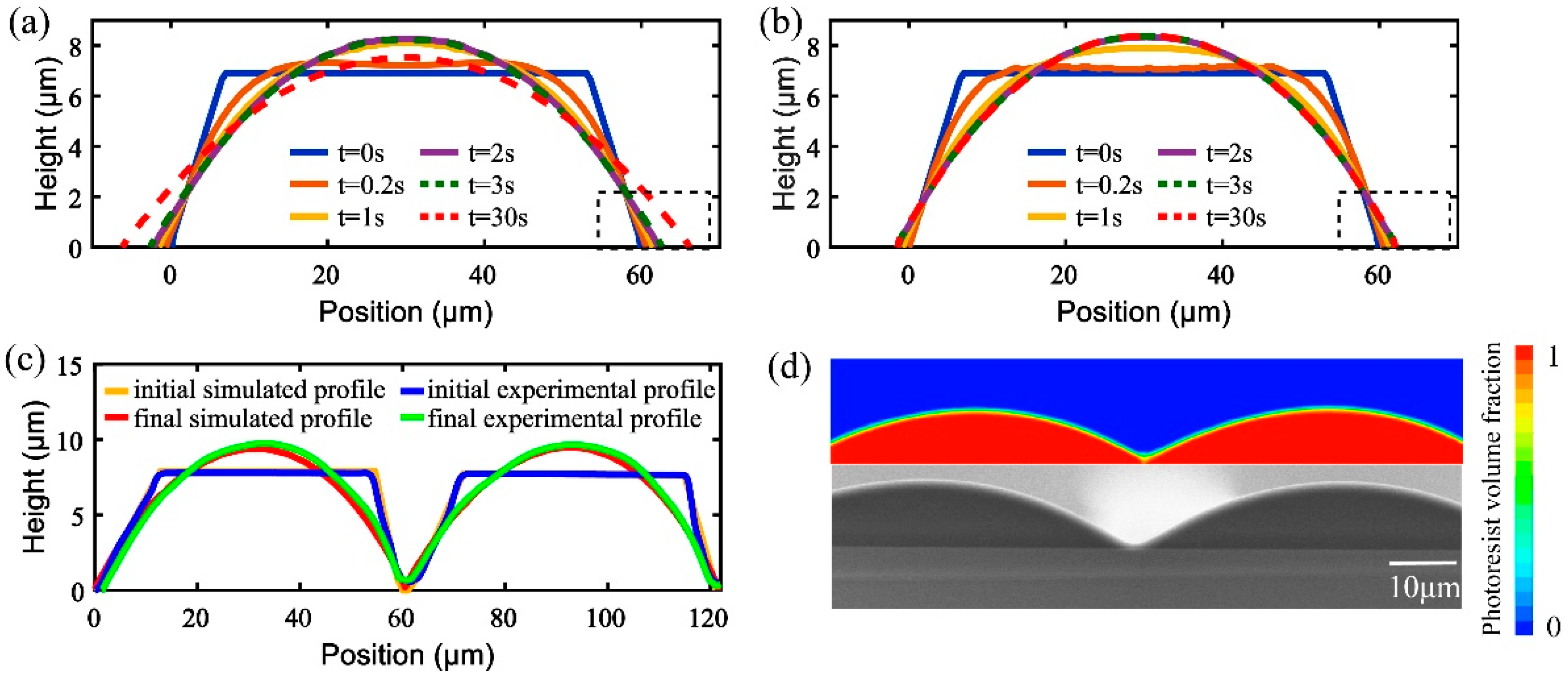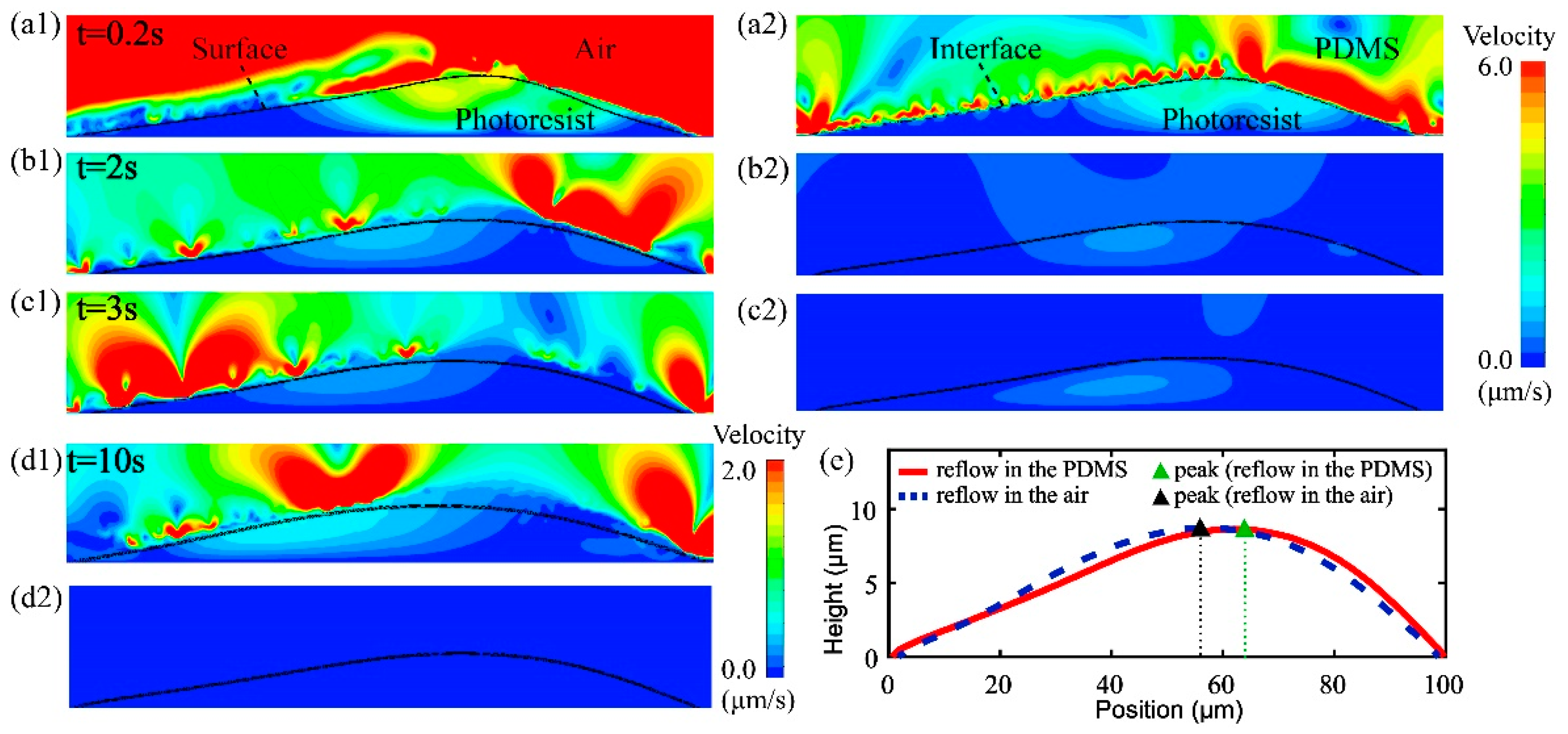Flow Performance and Its Effect on Shape Formation in PDMS Assisted Thermal Reflow Process
Abstract
:1. Introduction
2. Materials and Methods
2.1. Geometry Model and Boundary Conditions
2.2. Material Properties
2.3. Theoretical Model
3. Results and Discussion
3.1. Thermal Curing Process of PDMS
3.2. The Base Constraint Ability
3.3. The Shape Retaining Ability
4. Conclusions
Author Contributions
Funding
Institutional Review Board Statement
Informed Consent Statement
Data Availability Statement
Acknowledgments
Conflicts of Interest
References
- Heo, S.G.; Jang, D.; Koo, H.-J.; Yoon, H. Large-area fabrication of microlens arrays by using self-pinning effects during the thermal reflow process. Opt. Express 2019, 27, 3439–3447. [Google Scholar] [CrossRef]
- Dai, C.H.; Agarwal, K.; Choo, J.H. Ion-induced localized nanoscale polymer reflow for three-dimensional self-assembly. ACS Nano 2018, 12, 10251–10261. [Google Scholar] [CrossRef]
- Li, Y.L.; Li, K.S.; Gong, F. Fabrication and optical characterization of polymeric aspherical microlens array using hot embossing technology. Appl. Sci. 2021, 11, 882. [Google Scholar] [CrossRef]
- Xie, S.P.; Wan, X.J.; Wei, X.X. Fabrication of multiscale-structure wafer-level microlens array mold. Appl. Sci. 2019, 9, 487. [Google Scholar] [CrossRef]
- Jung, H.; Jeong, K.-H. Monolithic polymer microlens arrays with high numerical aperture and high packing density. ACS Appl. Mater. Interfaces 2015, 7, 2160–2165. [Google Scholar] [CrossRef]
- Bae, S.-I.; Kim, K.; Yang, S.; Jang, K.-W.; Jeong, K.-H. Multifocal microlens arrays using multilayer photolithography. Opt. Express 2020, 28, 9082–9088. [Google Scholar] [CrossRef]
- Lotz, M.; Needham, J.; Jakobsen, M.H.; Taboryski, R. Nanoimprinting reflow modified moth-eye structures in chalcogenide glass for enhanced broadband antireflection in the mid-infrared. Opt. Lett. 2019, 44, 4383–4386. [Google Scholar] [CrossRef]
- Kim, J.J.; Yang, S.P.; Keum, D.; Jeong, K.H. Asymmetric optical microstructures driven by geometry-guided resist reflow. Opt. Express 2014, 22, 22089–22094. [Google Scholar] [CrossRef]
- Hung, S.Y.; Chang, T.Y.; Shen, M.H.; Yang, H. Tilted microlens fabrication method using two photoresists with different melting temperatures. J. Micromech. Microeng. 2014, 24, 025013. [Google Scholar] [CrossRef]
- Qiu, J.; Li, M.; Ye, H.; Yang, C.; Shi, C. Fabrication of high fill factor cylindrical microlens array with isolated thermal reflow. Appl. Optics 2018, 57, 7296–7302. [Google Scholar] [CrossRef]
- Qiu, J.; Li, M.; Ye, H.; Zhu, J.; Ji, C. Fabrication of high fill-factor microlens array using spatially constrained thermal reflow. Sens. Actuator A-Phys. 2018, 279, 17–26. [Google Scholar] [CrossRef]
- Qiu, J.; Li, M.; Zhu, J.; Ji, C. Fabrication of microlens array with well-defined shape by spatially constrained thermal reflow. J. Micromech. Microeng. 2018, 28, 085015. [Google Scholar] [CrossRef]
- Jurgensen, N.; Fritz, B.; Mertens, A.; Tisserant, J.-N.; Kolle, M.; Gomard, G.; Hernandez-Sosa, G. A Single-Step Hot Embossing Process for Integration of Microlens Arrays in Biodegradable Substrates for Improved Light Extraction of Light-Emitting Devices. Adv. Mater. Technol. 2020, 6, 1900933. [Google Scholar] [CrossRef]
- Zhu, X.Y.; Xu, Q.; Hu, Y.J.; Li, H.K.; Wang, F.; Peng, Z.L.; Lan, H.B. Flexible biconvex microlens array fabrication using combined inkjet-printing and imprint-lithography method. Opt. Laser Technol. 2019, 115, 118–124. [Google Scholar] [CrossRef]
- Leveder, T.; Landis, S.; Davoust, L. Reflow dynamics of thin patterned viscous films. Appl. Phys. Lett. 2008, 92, 013107. [Google Scholar] [CrossRef]
- Hu, J.J.; Feng, N.N.; Carlie, N.; Petit, L.; Agarwal, A.; Richardson, K.; Kimerling, L. Optical loss reduction in high-index-contrast chalcogenide glass waveguides via thermal reflow. Opt. Express 2010, 18, 1469–1478. [Google Scholar] [CrossRef]
- Emadi, A.; Wu, H.; Grabarnik, S.; de Graaf, G.; Wolffenbuttel, R.F. Vertically tapered layers for optical applications fabricated using resist reflow. J. Micromech. Microeng. 2009, 19, 074014. [Google Scholar] [CrossRef]
- Zhang, H.; Li, L.; McCray, D.L.; Yao, D.G.; Yi, A.Y. A microlens array on curved substrates by 3D micro projection and reflow process. Sens. Actuator A-Phys. 2012, 179, 242–250. [Google Scholar] [CrossRef]
- Audran, S.; Mortini, B.; Faure, B.; Schlatter, G. Dynamical formation of microlenses by the reflow method: Numerical simulation and experimental study of the process fabrication. J. Micromech. Microeng. 2010, 20, 095008. [Google Scholar] [CrossRef]
- Kirchner, R.; Schift, H. Mobility based 3D simulation of selective, viscoelastic polymer reflow using Surface Evolver. J. Vac. Sci. Technol. B 2014, 32, 06F701. [Google Scholar] [CrossRef]
- Kirchner, R.; Schleunitz, A.; Schift, H. Energy-based thermal reflow simulation for 3D polymer shape prediction using Surface Evolver. J. Micromech. Microeng. 2014, 24, 055010. [Google Scholar] [CrossRef]
- Kirchner, R.; Schift, H. Thermal reflow of polymers for innovative and smart 3D structures: A review. Mater. Sci. Semicond. Process 2019, 92, 58–72. [Google Scholar] [CrossRef]
- Wu, S. Calculation of interfacial tension in polymer systems. J. Polym. Sci. Pt. C-Polym. Sym. 1971, 34, 19–30. [Google Scholar] [CrossRef]
- Bauer, J.; Drescher, G.; Illig, M. Surface tension, adhesion and wetting of materials for photolithographic process. J. Vac. Sci. Technol. B 1996, 14, 2485–2492. [Google Scholar] [CrossRef]
- Ismail, A.E.; Grest, G.S.; Heine, D.R.; Stevens, M.J.; Tsige, M. Interfacial structure and dynamics of siloxane systems: PDMS-vapor and PDMS-water. Macromolecules 2009, 42, 3186–3194. [Google Scholar] [CrossRef]
- Brackbill, J.U.; Kothe, D.B.; Zemach, C. A continuum method for modeling surface-tension. J. Comput. Phys. 1992, 100, 335–354. [Google Scholar] [CrossRef]
- Stieghorst, J.; Doll, T. Rheological behavior of PDMS silicone rubber for 3D printing of medical implants. Addit. Manuf. 2018, 24, 217–223. [Google Scholar] [CrossRef]







| Parameters | Unit | PDMS | Photoresist |
|---|---|---|---|
| Specific heat | J∙kg−1∙K−1 | 1540 | 1470 |
| Thermal conductivity | W∙m−1∙K−1 | 0.18 | 0.19 |
| Density | kg∙m−3 | 1030 | 1085 |
Publisher’s Note: MDPI stays neutral with regard to jurisdictional claims in published maps and institutional affiliations. |
© 2022 by the authors. Licensee MDPI, Basel, Switzerland. This article is an open access article distributed under the terms and conditions of the Creative Commons Attribution (CC BY) license (https://creativecommons.org/licenses/by/4.0/).
Share and Cite
Gong, S.; Shi, C.; Li, M. Flow Performance and Its Effect on Shape Formation in PDMS Assisted Thermal Reflow Process. Appl. Sci. 2022, 12, 8282. https://doi.org/10.3390/app12168282
Gong S, Shi C, Li M. Flow Performance and Its Effect on Shape Formation in PDMS Assisted Thermal Reflow Process. Applied Sciences. 2022; 12(16):8282. https://doi.org/10.3390/app12168282
Chicago/Turabian StyleGong, Shanshan, Cuicui Shi, and Mujun Li. 2022. "Flow Performance and Its Effect on Shape Formation in PDMS Assisted Thermal Reflow Process" Applied Sciences 12, no. 16: 8282. https://doi.org/10.3390/app12168282





